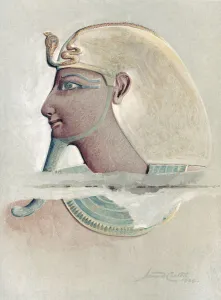Thutmosis Collection
Thutmose III, the mighty pharaoh of ancient Egypt, ruled from approximately 1490 to 1436 BC
All Professionally Made to Order for Quick Shipping
Thutmose III, the mighty pharaoh of ancient Egypt, ruled from approximately 1490 to 1436 BC. His reign was marked by great military conquests and architectural achievements that left a lasting legacy in Thebes and beyond. In the grand Tomb of Thutmose III, intricate paintings adorned its walls, depicting scenes from his victorious campaigns and religious rituals. One such painting showcases a colossal head believed to be that of Thutmose I, his predecessor. A polychrome relief captures Pharaoh Thutmose III himself in all his regal glory. With an army at his command, he led countless battles and expanded Egypt's territories far and wide. This awe-inspiring image is reminiscent of the illustrations found in Hutchinson's History of the Nations. The Book of the Dead provides further insight into Thutmose III's beliefs about the afterlife. A detail from this sacred text reveals his dedication to ensuring a prosperous journey into eternity. A statuette of a sphinx belonging to King Tuthmosis III exemplifies the artistic prowess achieved during Egypt's New Kingdom era. Crafted with meticulous precision, it stands as a testament to both royal power and cultural refinement. Karnak boasts magnificent obelisks erected during Thutmose I's reign – towering symbols of divine kingship that have endured through time. Carved onto a cartridge lies the praenomen (birth name) of Thutmose II – evidence not only of familial lineage but also dynastic continuity within Egyptian history. Another remarkable polychrome relief depicts god Amun-Min assuming pharaonic form – an embodiment of divine authority merged with earthly rule under Thutmose III’s reign. Egyptian reliefs offer glimpses into daily life during this period: farming activities, religious ceremonies, and even depictions showcasing royal figures like Thutmose I engaged in hunting expeditions or receiving tribute from foreign lands.

















